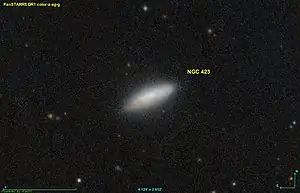| NGC 423 | |
|---|---|
 Pan-STARRS image of NGC 423 | |
| Observation data (J2000 epoch) | |
| Constellation | Sculptor |
| Right ascension | 01h 11m 22.2s[1] |
| Declination | −29° 14′ 04″[1] |
| Redshift | 0.005344[1] |
| Heliocentric radial velocity | 1,602 km/s[1] |
| Apparent magnitude (V) | 14.20[1] |
| Absolute magnitude (V) | -18.22[1] |
| Characteristics | |
| Type | S0/a?[1] |
| Apparent size (V) | 1.0' × 0.4'[1] |
| Other designations | |
| ESO 412- G 011, MCG -05-04-004, 2MASX J01112221-2914042, 2MASXi J0111222-291403, IRAS 01090-2929, F01090-2929, ESO-LV 4120110, 6dF J0111222-291404, PGC 4266.[1] | |
NGC 423 is a lenticular galaxy of type S0/a? located in the constellation Sculptor. It was discovered on November 14, 1835 by John Herschel. It was described by Dreyer as "extremely faint, small, extended, gradually a little brighter middle, eastern of 2.", the other being NGC 418.[2]
References
External links
 Media related to NGC 423 at Wikimedia Commons
Media related to NGC 423 at Wikimedia Commons
This article is issued from Wikipedia. The text is licensed under Creative Commons - Attribution - Sharealike. Additional terms may apply for the media files.